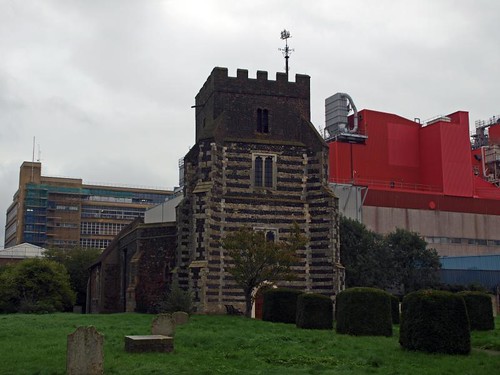This was originally a Norman round church (Pevsner misreports the original nave foundations as round tower foundations) which, had it survived, would have been a rarity. Redundant it was restored and returned to community use in 1987 by P&G but prior to this the Victorians obviously had a go. It shouldn't work but I liked it.
Oh and it was used as the funeral church in Four Weddings and a Funeral.
ST CLEMENT. The most remarkable thing about the church is its position, lovely and rather forlorn in the marshes, cut off by the railway from the village and now overtowered by a modern factory just E of it. The church has a handsome C15 W tower with diagonal buttresses and stripes of flint and stonework. The top brick. This tower replaced a former circular tower. The oldest features of the church are the tiny C12 N aisle W windows and the plain N doorway. Then follows the N arcade of two bays (circular pier and double-chamfered arches), the S arcade (octagonal pier and double-chamfered arches), N transept (now N chapel) and the chancel. Their windows are cusped lancets (Chancel N and s), and two cusped lancet lights and a quatrefoil above (N chapel E, with two blank lancets to the l. and r. Was this originally a stepped-lancet-group ?). The N chapel N windows are C14. So are the octagonal piers to the N and S chapels. - FONT. Perp, octagonal, with quatrefoil panels. - COMMUNION RAIL. Early C17. - STAINED GLASS. Various small bits, especially E window. - TILES. In N chapel, re-set, early C14 fleurs-de-lis, foliage, eagle etc. - PLATE. Cup of 1564. - MONUMENTS. Coffin lid of Purbeck marble with foliated cross, C13. - Brass to Humphrey Heies d. 1584 and son (hidden by chancel seats). - Sir Christopher Helford d. 1608 and Lady Helford, two stiff semi-reclining alabaster figures, not in their original context.
WEST THURROCK. It lies by the Thames, and its neighbour Grays is spreading its industries over its borders. The great chalk quarry cut into the steep hill behind it is a grand foreground of a magnificent view of the Thames towards Gravesend, the walls of the quarry rising in grey tiers above a green pool. In the distance sweeps the majestic river with barge and hurrying tug and stately liner on its gleaming surface. Standing out, solid and solitary in the waterside wastes, is the 15th century tower of the church, with flint bands round it. It was one of the churches at which pilgrims would call on their way to Canterbury.
In a hole by the tower can still be seen the foundations of the church of Norman times; it had a round nave 25 feet wide, a very rare feature in our ancient buildings. The present nave was the chancel of the round church. The aisles were added about 1200, and the chancel with its two chapels 50 years after, rapid expansions suggesting considerable pilgrim traflic. The arcades of the chapels and the higher roofs belong to the 14th century, when the jolly curly-haired head of a king smiling over a door was carved.
A great stone under the altar lies over the grave of one who shared in these busy scenes. His lost brass, showing him resting on a beast, can only be imagined from its impression on the stone, but the deep lettering round the edge has preserved his name, Nicholas Ferobaud. He died 1315. Close by are portraits of Humphrey Heies, who died in 1584, and his young son, who wears a ruff. Latin scholars enjoy the many puns in this inscription.
There are alabaster figures of Sir Christopher Holford and his wife in a chapel, brought back into the church from a rubbish heap. He is in armour and his lady in rich clothing. Below him is a stone coffin of the 13th century, and worked into the wall are rare 14th century tiles with eagles and leopards and other rare patterns. Many fragments of glass of that century gleam from the windows. The font is rare because it is of chalk, carved in the 15th century with shields, a rose, a four-leaved flower, the sun, and a holy lamb.
In a hole by the tower can still be seen the foundations of the church of Norman times; it had a round nave 25 feet wide, a very rare feature in our ancient buildings. The present nave was the chancel of the round church. The aisles were added about 1200, and the chancel with its two chapels 50 years after, rapid expansions suggesting considerable pilgrim traflic. The arcades of the chapels and the higher roofs belong to the 14th century, when the jolly curly-haired head of a king smiling over a door was carved.
A great stone under the altar lies over the grave of one who shared in these busy scenes. His lost brass, showing him resting on a beast, can only be imagined from its impression on the stone, but the deep lettering round the edge has preserved his name, Nicholas Ferobaud. He died 1315. Close by are portraits of Humphrey Heies, who died in 1584, and his young son, who wears a ruff. Latin scholars enjoy the many puns in this inscription.
There are alabaster figures of Sir Christopher Holford and his wife in a chapel, brought back into the church from a rubbish heap. He is in armour and his lady in rich clothing. Below him is a stone coffin of the 13th century, and worked into the wall are rare 14th century tiles with eagles and leopards and other rare patterns. Many fragments of glass of that century gleam from the windows. The font is rare because it is of chalk, carved in the 15th century with shields, a rose, a four-leaved flower, the sun, and a holy lamb.

No comments:
Post a Comment